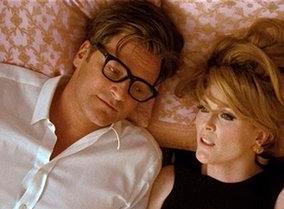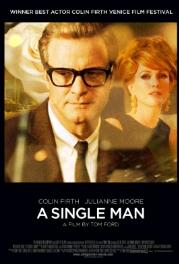Style Over Substance
Described by novelist Edmund White as “one of the first and best novels of the modern gay liberation movement,” Isherwood’s “A Single Man” presents a stream-of-consciousness portrait of a middle-aged gay man, known only as George, going about his daily routine in early ‘60s LA. On-screen, virtually the entire film, often alone with only the bottomless grief on his face driving the scene, Firth is riveting, the vibrant charm of his work in “Bridget Jones’s Diary” and other frothy romances easily co-existing with his character’s melancholy.
 It’s a tragic but simple story, Firth’s George Falconer, a British professor of English at a Los Angeles campus, going about what he intends to be the last day of his life, with the peril of the Cuban missile crisis playing out in the background. Through flashbacks, we relive tender moments of his home life with Jim (Matthew Goode) and the awful day when George got word that his companion had died in a car wreck. As George passionately lectures students, has a close encounter of potential romance with a stranger and shares witty phone chatter over preparations for an evening with dear friend Charley (Moore), it becomes clear that he plans to kill himself at day’s end, no longer able to go on without Jim.
It’s a tragic but simple story, Firth’s George Falconer, a British professor of English at a Los Angeles campus, going about what he intends to be the last day of his life, with the peril of the Cuban missile crisis playing out in the background. Through flashbacks, we relive tender moments of his home life with Jim (Matthew Goode) and the awful day when George got word that his companion had died in a car wreck. As George passionately lectures students, has a close encounter of potential romance with a stranger and shares witty phone chatter over preparations for an evening with dear friend Charley (Moore), it becomes clear that he plans to kill himself at day’s end, no longer able to go on without Jim.
Firth and Moore capture a great sense of familiarity and fraternity in George and Charley’s friendship - the sort of relationship that can erupt from boozy good humor to fierce reproach and back again without any permanent damage. The detail Ford applies to the production design is a marvel. Big-finned cars, narrow ties, thick eyeglass rims, stiffly sculpted hair, exquisite dresses for a casual evening at home, it all evokes a beauteous world that’s maybe too idealized to have ever really existed but is just a treat to look at. The house of glass walls that George shared with Jim provides a grand window into a grieving man’s soul. What once was a haven for George now is a wound torn open for anyone who wants to peer inside.
George’s meticulous arrangements for his suicide and its aftermath - the plans ranging right down to laying out his burial suit - were not part of Isherwood’s novel. Ford added the suicide element, which strengthens the cinematic tension and even adds a dash of macabre humor asGeorge experiments with the best angles at which to hold the gun that will blow his head off. But George’s intent to end his own life winds up undermining the film’s finale, bringing rather coarse, even bludgeoning irony to the man’s fate. It’s a dissatisfying conclusion to an otherwise involving day in the life played to perfection by Firth.
Firth's measured performance, delivered in a clipped British accent, has just the right restraint, and the intelligent dialogue is a pleasure. Moore is glamorous and likable as the alcoholic divorcee Charley, adrift without a husband. Goode and especially Hoult are just too perfect to be true, but they serve the purpose of offering George good reasons to stay alive. In contrast to Firth's underplaying, the directing has its overblown, operatic soul. Ford is unafraid of such cringeworthy moments as playing an opera solo over a suicide attempt or having a nattily dressed symbolic figure in Tom Ford Menswear give the kiss of death to the recently departed. In the same spirit, tech work is satisfyingly bold. Dan Bishop's stylish production design and Eduard Grau's cinematography set the film in a romantically idealized '60s world. The film score written by Abel Korzeniowski and Shigeru Umebayashi is variegated and full of lush orchestral themes that salute Hitchcock and Bernard Hermann, among others.

0 comments:
Post a Comment